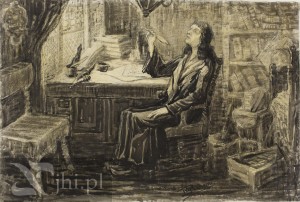Before the Second World War even began, Hitler and the Nazis made lists of art across Europe that they coveted. And not only did they desire it, once their march across Europe began, they openly sought out and took whatever they could. While much of their focus was on what one might call “the greatest artwork of Western European culture,” the Nazis pretty much stole everything imaginable. Yes, they took fine art, sculpture and collectibles like coins, gold, and books. But they took so much more. They stole jewelry, Torah scrolls, furniture, dinner place settings, musical instruments, and people’s personal photo albums. Nothing was too big or too small to take. Much of the thieving was about possessing great works – but much of the taking was also about the humiliation and the attempt to erase and deny people their humanity, their culture, their place in history.
It is unlikely that the Nazis would have desired my great-grandfather’s paintings. Not only was he a Jewish artist but he painted scenes of the Jewish community and he was a relatively unknown artist. His work would most likely have been declared degenerate and destroyed. In fact, the Rynecki family always assumed that the vast majority of the original collection of 800+ paintings and sculptures were accidentally burned in one or more of the many waves of devastation visited on Warsaw, or worse, intentionally destroyed by others because of the subject matter of the pieces. Consequently, each new discovery of a formerly “lost” Moshe Rynecki painting feels like a victory, not only for my own personal quest to discover the lost and missing pieces, but as a symbol of resistance to the Nazis efforts to erase the Jewish people from history. While Moshe Rynecki perished in a Nazi concentration camp, his surviving pieces speak volumes of a world and a people who once thrived in Poland.
This piece is one of 17 that the Jewish Historical Institute (ZIH) in Warsaw recently emailed me. The museum possesses 52 of my great-grandfather’s paintings. According a spreadsheet I have from the museum, this piece was acquired in 1964. I do not know who had it previously. ZIH has titled the piece, “Portret Uriela Acosty/Uczony/Kronikarz” which I believe partially translates to: Portrait of scholar/chronicler. It is dated 1931.
